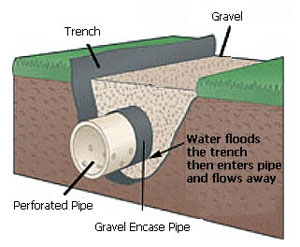Definition
A filter drain is a gravel filled trench, generally with a perforated pipe at the base. Runoff flows slowly through the granular material, trapping sediments and providing attenuation. Flow is then directed to a perforated pipe, which conveys run-off either back into the sewerage network or into a waterbody. Filter drains are mainly used to drain road and carpark surfaces. Ideally these systems are used as a component of a treatment train. (Clifton Scannell Emerson Associates Limited, 2011, p. 38)Co-benefits and impacts
Filter drains provide attenuation, limited treatment and minimal safety risk. Furthermore, they are relatively inexpensive, require low land take and can be used in most soil-conditions provided run-off discharges into a perforated pipe rather than to soil. Limitation of the filter drains are that no habitat or amenity value provided, they do not provide any biological treatment, since they are subsurface structures, operational problems are not always visible and they require regular maintenance. (Clifton Scannell Emerson Associates Limited, 2011, p. 38)Conditions
Filter drain are not suitable where groundwater levels are high, i.e. likely to come within 1.5m of the base of the device and they are not suitable for industrial areas unless treatment is provided upstream of the device and operates as part of a treatment train. (Clifton Scannell Emerson Associates Limited, 2011, p. 38)Definition (GR)
Τα φίλτρα αποστράγγισης με στραγγιστήριο αγωγό, αποτελούνται ουσιαστικά από μια τάφρο γεμισμένη με χαλίκια, με ένα κατάλληλο διάτρητο σωλήνα στη βάση τους. Η απορροή ρέει αργά μέσω του κοκκώδους υλικού, παγιδεύοντας ιζήματα και αποσβένοντας τη ροή. Στη συνέχεια, η ροή κατευθύνεται σε έναν διάτρητο σωλήνα, ο οποίος μεταφέρει την απορροή είτε πίσω στο δίκτυο αποχέτευσης είτε σε ένα υδάτινο αποδέκτη. Τα φίλτρα αποστράγγισης χρησιμοποιούνται κυρίως για την αποστράγγιση των επιφανειών των οδών και των χώρων στάθμευσης. Ιδανικά αυτά τα συστήματα χρησιμοποιούνται ως τμήματα ενός δικτύου συλλογής και επεξεργασίας. (Clifton Scannell Emerson Associates Limited, 2011, p. 38)Co-benefits and impacts (GR)
Τα φίλτρα αποστράγγισης παρέχουν εξασθένηση, περιορισμένη επεξεργασία και ελάχιστο κίνδυνο ασφαλείας. Επιπλέον, είναι σχετικά οικονομικά, απαιτούν μικρή έκταση γης και μπορούν να χρησιμοποιηθούν στα περισσότερα εδάφη, υπό την προϋπόθεση ότι οι απορροές οδηγούνται σε διάτρητο σωλήνα και όχι στο έδαφος. Περιορισμοί των φίλτρων αποστράγγισης είναι ότι δεν μπορούν να εφοδιάσουν κάποιον οικότοπο ή να αυξήσουν την αξία κάποιας περιοχής, τα ύδατα δεν υπόκεινται σε κάποια βιολογική επεξεργασία, αφού πρόκειται για υπόγειες κατασκευές, τα όποια προβλήματα κατά τη λειτουργία τους δεν είναι πάντοτε ορατά και απαιτούν τακτική συντήρηση.(Clifton Scannell Emerson Associates Limited, 2011, p. 38)Conditions (GR)
Τα φίλτρα αποστράγγισης δεν είναι κατάλληλα όταν τα επίπεδα των υπόγειων υδάτων είναι υψηλά, δηλαδή πιθανόν να ανέλθουν σε 1,5μ από τη βάση της κατασκευής και δεν είναι κατάλληλα για βιομηχανικές περιοχές, εκτός εάν η επεξεργασία των αποβλήτων πραγματοποιείται ανάντη της κατασκευής και το σύστημα αποστράγγισης λειτουργεί ως τμήμα ενός δικτύου συλλογής και επεξεργασίας. (Clifton Scannell Emerson Associates Limited, 2011, p. 38)Land uses
Land uses in which this measure can be applied.
Flood management measure
The parent measure, in terms of this measure being a subcategory of the parent one
Synonym of Flood management Measure
Last modified: June 20, 2020, 12:36 p.m.


 Ελληνικά
Ελληνικά
